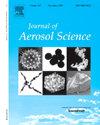Investigation of the morphology and optical properties of graphene oxide for online diagnostics
IF 2.9
3区 环境科学与生态学
Q2 ENGINEERING, CHEMICAL
引用次数: 0
Abstract
Graphene oxide (GO) particles have a wide and growing range of applications. They may also be converted to reduced graphene oxide (rGO) particles, which are increasingly used in energy storage devices like batteries and supercapacitors. However, the downstream functionality of GO and rGO particles depends strongly on their morphology, which is highly variable depending on the synthesis process. Here, we report morphological and optical properties for GO particles in the aerosol phase. These include the mobility diameter, effective density (0.93 ± 0.06 g/cm3), mass–mobility exponent (2.97 ± 0.06), Angstrom absorption exponent (2.48 between 370 nm and 950 nm), mass absorption cross-section (0.99 ± 0.22 m2 g−1), and mass scattering cross-section. Although this study reports measurements on re-aerosolized GO powder, the demonstrated techniques and measured properties serve as a foundation for in-reactor optical diagnostics that may allow for online control of the synthesis processes enabling the ability to control and characterize the functionality of downstream particles
用于在线诊断的氧化石墨烯的形态和光学性质的研究
氧化石墨烯(GO)颗粒具有广泛且不断增长的应用范围。它们也可以转化为还原氧化石墨烯(rGO)颗粒,这种颗粒越来越多地用于电池和超级电容器等储能设备。然而,氧化石墨烯和还原氧化石墨烯颗粒的下游功能在很大程度上取决于它们的形态,这取决于合成过程。在这里,我们报告了氧化石墨烯颗粒在气溶胶相的形态和光学性质。包括迁移率直径、有效密度(0.93±0.06 g/cm3)、质量迁移率指数(2.97±0.06)、埃吸收指数(2.48)、质量吸收截面(0.99±0.22 m2 g−1)和质量散射截面。尽管本研究报告了对再雾化氧化石墨烯粉末的测量,但所展示的技术和测量的特性可作为反应器内光学诊断的基础,可以在线控制合成过程,从而能够控制和表征下游颗粒的功能
本文章由计算机程序翻译,如有差异,请以英文原文为准。
求助全文
约1分钟内获得全文
求助全文
来源期刊

Journal of Aerosol Science
环境科学-工程:化工
CiteScore
8.80
自引率
8.90%
发文量
127
审稿时长
35 days
期刊介绍:
Founded in 1970, the Journal of Aerosol Science considers itself the prime vehicle for the publication of original work as well as reviews related to fundamental and applied aerosol research, as well as aerosol instrumentation. Its content is directed at scientists working in engineering disciplines, as well as physics, chemistry, and environmental sciences.
The editors welcome submissions of papers describing recent experimental, numerical, and theoretical research related to the following topics:
1. Fundamental Aerosol Science.
2. Applied Aerosol Science.
3. Instrumentation & Measurement Methods.
 求助内容:
求助内容: 应助结果提醒方式:
应助结果提醒方式:


